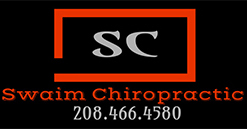Frequently Asked Questions | Swaim Chiropractic | Nampa, Idaho
Welcome to the Swaim Chiropractic FAQ!
We know that starting chiropractic care can come with a lot of questions, and we’re here to help. Below you’ll find answers to some of the most common inquiries we receive from our patients. Whether you’re new to chiropractic or just curious about what to expect, we hope this page gives you the clarity and confidence you need. If you don’t see your question here, feel free to reach out—we’re always happy to chat!
1)What is that clicky thing?
Answer: Great question. That clicky thing is an activator, which sounds more like a character from a Marvel movie than an extremely precise chiropractic tool. Most people equate chiropractic with cracking joints, and for most of our 130 year history, that is exactly what happened in most chiropractic offices worldwide. But in the 60’s a few chiropractors from Minnesota, one of them Dr. Arlan Fuhr, were piecing together a low force technique that would be easy on them, and gentle on the patient. So they began working on a fast spring loaded instrument that required a fraction of the force to move a joint. The activator tool is so fast, essentially 300x faster than your nervous system, a correction can be made with very little force and move the joint farther than with an old school manual adjustment. The key is knowing when, where and when not to adjust and that is what the analysis, the Activator Method, accomplishes.
2)How do you know where to click that thing?
Answer: The genius of the Activator is the Activator Method. When Dr. Arlan Fuhr began to develop this low force/high speed technique, he quickly realized that the spine and pelvis have predictable movement patterns that can be recreated while a person is lying face down. He also borrowed, as is common in chiropractic, from an older technique that used a leg length analysis. The Activator Method is a way to analyze spinal and extremities dysfunction. By using a leg length measurement, we can quickly and easily and most importantly, consistently, assess which joints are working and which ones need to wake up and help. It really is a terrific tool for getting you the right adjustment at the right time
3) Does getting a chiropractic adjustment, especially with an activator hurt?
Answer: No. The activator is extremely comfortable because it is low force and high speed.
4) Why don’t you accept insurance?
Answer: We stopped accepting insurance in 2017 because insurance interfered with your care! Insurance companies limit the amount and type of care that you are able to receive based on a business model that has nothing to do with how people heal. Couple that reality with a complete misunderstanding of chiropractic, and you have a very dysfunctional relationship, one we want to avoid. We want to have a contract with you and be accountable to you, the human being, not a corporation that doesn’t know either one of us. It seems strange that healthcare decisions are made by a person in a cubicle armed with an algorithm. Don’t you think? If you agree that your health is between you and me, you are in the right place!
5) Why do I have to keep coming back?
Answer: You don’t. But if you want the results you seek, then for a short time you will need to come back. From your body’s point of view, it needs to learn to hold an adjustment. One adjustment builds on the next so the sequencing is important. The follow up and the repetition is where the magic happens. We are trying to teach an old dog a new trick. And the older the dog, the longer it takes to learn a new trick. How old is your dog?
